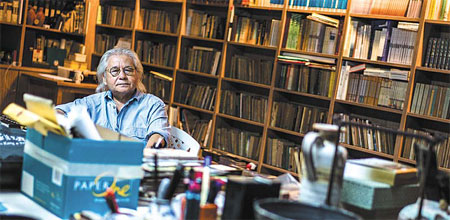 |
| Artist Lin Xiangxiong in his study. Photos Provided to China Daily |
Lin Xiangxiong refuses to paint between the lines that divide East from West
Among overseas Chinese artists, Singaporean painter Lin Xiangxiong is distinguished as an expert in combining Chinese and Western elements, critics say.
Lin's creations combine the freehand brushwork used in traditional Chinese paintings with the bold colors of Western impressionism. His works are full of the kind of compassion that is typical of Chinese literati, critics have said.
This mixture is Lin's signature style, said Xu Jialu, president of the China Institute of Culture.
"It is not easy for Chinese paintings and calligraphy to go global because there are different expression systems and notions of aesthetics," Xu said.
But Lin has found a way to cross the cultural divide. Born in Shantou, Guangdong province in 1945, he still treasures the memory of drawing on the ground with a twig in the countryside, though his childhood was tough.
After traveling through Southeast Asia as a teenager, he studied painting in Singapore in the 1970s and then moved to France to continue the pursuit of his dream for another three years.
Despite the Western techniques he learned, the artist still found he prefers using brushwork and rice paper, a kind of fine paper especially for calligraphy and paintings.
In Lin's paintings, the Chinese elements dovetail nicely with those of the West, which is "really impressive", said Zhang Gongzhe, vice-president of the Chinese Calligraphers and Painters magazine.
"His use of colors gives his works the feel of the West, while in essence, the paintings still remain in a Chinese style," Zhang said.
"From the strong colors, I see his concerns and anxiety over the hardship faced by average people," he said, adding that the ultimate goal for artistic works is not to please the eye but to probe deeply into the human condition.
Xia Shuoqi, editor of The Art, said he is representative of the Nanyang or Southeast Asian school.
The Nanyang school is the result and reflection of the Chinese influence over the South Asian region, Xia said. "At its core is the inheritance of traditional Chinese art."
In China, the pursuit of abstractionism, rather than restriction to formality, is common in various traditional art fields, especially in painting. And it's also highlighted in Lin's creations, Xia said.
Zhang noted: "Lin's paintings speak for more than themselves. They represent his thought and values, convey his understanding of life, and express concerns about the suffering of ordinary people."
Xu said Lin's perspectives are not limited to his own life. His paintings cover a variety of subject matter, including workers in the Southeast Asian jungles, returning fishermen in the twilight, ruins in Iraq, poverty in Africa, and foreign laborers cleaning streets near skyscrapers.
"We can see far beyond the paintings," Xu said.
Wang Yong, editor-in-chief of the Chinese Calligraphers and Painters magazine, said that Lin's own experience of struggling from the bottom of the social ladder is at the root of his attitude toward ordinary people.
With a belief that artists should serve as the conscience of the society, the Chinese-Singaporean art veteran created a host of works showing compassion toward ordinary people.
